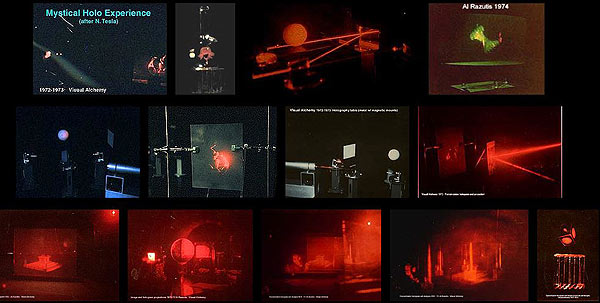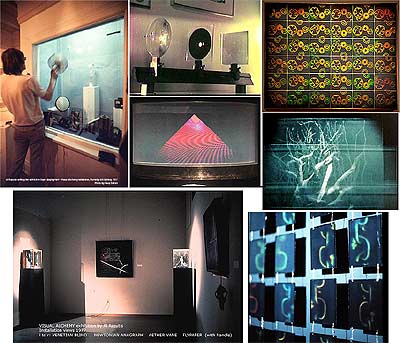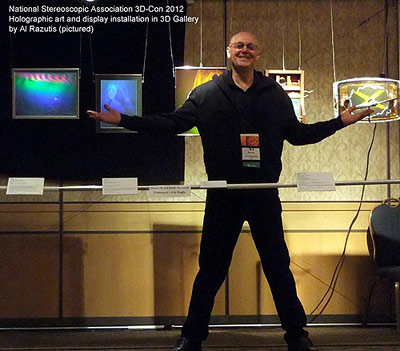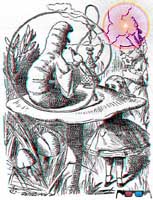'HOLOGRAPHIC HISTORY at VISUAL ALCHEMY VANCOUVER'Essay and holograms by Al Razutis - Vancouver/Saturna Island, Canada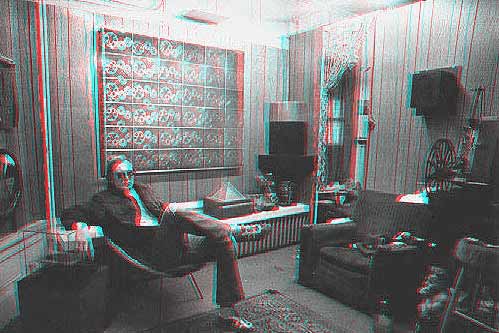
'A studio of levitations and gears of light' - 1976 Full Pictorial of Early Studio & Works The companion piece to Intro to talking about holography and art (2010) 
History is written by people, not their machines. The occurrence of any new art or visual medium is a process of invention, application, and memory. Gabor invents a theory of holography in the 1940's, waiting for a suitable 'lightbulb' like the 1960 invention of the laser by Maiman to prove that 'holograms can be recorded' and displayed to scientists and artists who said 'wow!'. We recall that Einstein's 1904 (theory of the) Photo Electric Effect took years to 'prove', and then came the Nobel Prize. So too with Dennis Gabor's Nobel Prize which came after optical holography was enough 'proof' that such a thing not only exists but is 'marvelous' to the scientists, engineers, and artists who took up the field of holography in their respective ways and labors.
There are gaps between an artist's discovery of a 'hologram' and 'holography' (as a physical fact and physical science), along with the 'rush', the inspiration, the 'aaahhh!' that comes with discovery, and the tough road of building lasers, optical tables, darkrooms, labs, display environments which are the 'publication' and the 'proof', and subject to future 'peer review' and critical, historical evaluation. The relationships between the arts and sciences are not all about 'which came first' but about how did they mutually 'inform' each others throughout the decades, if not centuries. How did scientists get 'inspired' to theorize such and such? Were the arts part of that equation? How did artists get inspired by a scientific discover like holography? Did they have to be physicists first? Did they have to collaborate with one? Or could they 'imagine' holography in a new way, and set about working on their own 'proofs'?
It appears to me that holographic artists, in particular, have been as patient as the Gabors and the Einsteins of physics. Certainly this is true in the ongoing works of Fred Unterseher, the scholarship of Andrew Pepper, the curating by Linda Law and exhibition of works by the late Ruddie Berkhout, the collections (and their exhibitions) of JonaThan Ross, and the 2010 Deja Vu - Holographic Art & 3D Exhibition by Al Razutis, Melissa Crenshaw and Gary Cullen, plus invited artists. In my 1970's holographic studio works, the art concept that includes material and imaginary subjects, sometimes described as 'inspiration' and 'imagination's works', requires both a personal and social 'proof' (the machine, the laser hologram, the exhibition, the peer-group and critical response), and even a more personal satisfaction derived from the pre-non-para-scientific 'alchemy' that interested me, and the publication of these works via exhibition, deliberately named 'Visual Alchemy' (1977). Between idea, proof, publishing and acceptance or peer critical revue there are also gaps with resulting 'memory' as recorded , re-discovered, revised (e.g., here, on this very page) of these contributing disparate events and people. My memory is 'not objective' but selective (to Visual Alchemy era in this essay) and began in the 1990's (Visual Alchemy web site) as imperfect web recollections that are refereshed and re-stated. In this short essay, I wished to set down my memories concerning the history of Visual Alchemy studio in Vancouver, a studio that I peronally built with assistance from others, where my work, and sometimes the works of others, was conducted in the post-60's experimental and avant-garde art cultures of Vancouver, Canada. The focus is on the holographic arts conducted at the studio; less is said about the 'technology', 'business aspects', or my interests in 'alchemy', since these would be subjects of other essays. This work adds to what could be generally referred to as the 'history of holographic art in Canada' or more generally the 'history of holographic art'. N.B. If there are errors of ommission noted by the reader, then contact writer for corrections at alrazutis@ymail.com. The 1970's and Holographic Art at Visual Alchemy, Vancouver (2001-2004 Essay) Holographic
imaging was developed at Visual Alchemy Inc. (History Chronology) - History Photo Page -
in 1972-77 as a new media joining my then present work and
facilities in experimental film and video. The physical space --
typical of technical studios in the 60's and 70's -- was full of
machines (optical printer, animation stand, editing rooms, etc.)
and low of living comforts. Here, one could say, the
'Visual Alchemy' consisted (in part) of visualizing virtual
medias into existence, and by virtue of experimenting with their (Plato's) cave-like
shadow-reflections of the 'real' (that which is called objective)
world-object-scenes - recorded photograhically or holographically. This
was a time of cross-disciplinary exploration, experiments in
various medias, and much of the inspiration for this holographic
work came from the 'inter-media' environment in the arts. Since
holography, per se, had yet to be established as an 'art form'
(there were no exhibitions of 'fine art holography' in Canada at
the time), all form of experimentation was possible. And there
were no precedents, rules, or 'examples' of correct or incorrect
'expression'. Canadian arts funding and the beginnings of holographic art Seed
moneys for holography came in the form of two consecutive Canada
Council for the Arts Senior Arts Grants (1971, 1973) (with the direct support of Penni Jacques,
Film Officer) and some special project funding from the Vancouver
office of the National Film Board of Canada (Peter Jones,
producer). These people and organizations took a chance on
something no one (except for a few physicists) had seen or
understood in Canada.
My ongoing work in avant-garde film, animation - opticals, video and videosynthesizers, with assistance provided by Gordon Kidd and collaborations with Gary Lee-Nova, were expanded with grant funds to include holography.
I was soon joined in the 'holographic adventure' by Catharine MacTavish - solo artist and partner in many adventures, and paid assistants, notably Rick Gibson. The various experiments with holographic image making, projection, and the creation of 'holograms' as metaphycis, art, imaging technology, novelty and plaything were undertaken until 1977 in studio rooms with black walls resulting in a traveling exhibition. A Canadian who took up holography in the US, Jerry Pethick, one of the 'originals'
in 'sandbox holography' (Ann Arbor, Michigan), formed a school (School of Holography, San Francisco) and collaborated
with another holographic pioneer, Lloyd Cross in the early 70's. He once came by to my studio in the mid-70's, looked about,
and told me to "forget it"...(that) someday I'll "really
get to hate making art exclusively in a darkroom." as he indicated he was 'done' with holography. He
was right in my case,...but that 'someday' happened years later
when I left the whole thing behind and travelled to Samoa (only
to return again, with more work in the 80's, 2000's...and to this day). Temporary absence, not departure from Visual Alchemy is the story of holography at Visual Alchemy, and to this day. See the history in pictures > Visual Alchemy Studio Early Holography
The first holograms at Visual Alchemy Early
work at Visual Alchemy consisted of 4x5" and 8x10" glass plates recording 'stable' objects over long duration exposures 'frozen' in time and isolated from vibrations by means of 'isolation' tables. Photo processing of the high-resolution photographic plates was conducted in a makeshift darkroom. The projected holographic image ('floating in space') was certainly the overwhelming and initial fascination, but this fascination was tied to principles of 'visual alchemy' rather than technical representation (mimetic fidelity to original subjects). Work soon involved larger format (up
to 36" x 30") transmission holograms, white-light reflection
holograms, cylinder (spatially multiplexed) holograms, and
multi-media holographic sculptures, like the one depicted in 'Aether Vane' - 1976. Refer to the list of early works and exhibitions contained
in Early Holographic Art The laboratory facilities included two custom-made isolation tables (metal top and large sandbox), custom-built He-Ne lasers (power supplies built by Bill Hewitt and Jim Armstrong), and an assortment of optics, and darkroom elements. It is fair to say that in these 'early days' of art holography, there were few established technical precedents,and no presumptive aesthetics to follow. Everything was created in the spirit of 'invention' and discovery. I pursued the work in relative geographic and cultural isolation - the only other studios that began later in the 70's were in Canada were at Fringe Research, in Toronto, operated by Michael Sowdon and David Hlynsky, and the labs and teaching facilities of Michael Page (Ontario College of Art and later Photon League). However, none of this work at Visual Alchemy could be accomplished completely solo. I greatly benefited from the assistance of Catharine MacTavish (holography), Gordon Kidd (film opticals), and later, Rick Gibson (holography). All of these mentioned individuals had independent careers and were responsible for accomplished work outside of this studio chronology. Also noteworthy in their support and technical advice during the 70's were Dr. Leigh Palmer of the Physics Department at Simon Fraser University, Burnaby, British Columbia, and the independent technical-electronic creators Jim Armstrong and Jerry Barenholtz. While I offered classes and workshops in holography at Visual Alchemy and later at Banff Centre for the Arts (Theater Design) with the collaboration of Catharine MacTavish, most of the holography work at Visual Alchemy concerned the creation of strange 'hybrid' multi-media pieces which integrated holograms with sculptural and graphic elements. This early work (1973-74) was considered 'tests' for the final series of pieces which would comprise the travelling exhibition "Visual Alchemy" (list of works) The exhibition climate for holographic art in the 1970's From inception, it was my contention that holography should not be exhibited until some kind of aesthetic rationale had been developed. In this, I was in the 'minority', since several exhibitions (including one that travelled from New York to Vancouver Art Gallery 1976) were mounted featuring generic-toy technical holograms made by technicians, scientists, display holographers trying out the medium on a curious public. Lacking a critical climate, the holographic medium (in the 70's) featured a 'melange' of aesthetic styles, exorbitant claims as to its 'future', presence of trite subject matter competing with more serious investigations, and the usual claims of 'this is the first of its kind'. Refer to my WAVEFRONT (Summer 1985, Winter 1985) "ART AND HOLOGRAPHY" essays, Part One,and Part Two, for a detailed discussion of this subject. Creating the 'Visual Alchemy' touring holographic exhibition
Preparations for this exhibition were assisted principally by Rick Gibson who was trained to be holographic laboratory (plate processing) assistant and holographer in 1975-6, and Martin Grove who would undertake to be the travelling curator and installation officer for the year-plus Canada-wide tour of the entire show 1977 - 1978. The innaugural exhibition (curated by Elisa Anstis) opened in 1976 at the Burnaby Art Gallery, the sponsor of this exhibition, and the organizing sponsor of the travelling exhibition. The innaugural exhibition was followed by a exhibition in Ottawa (under the sponsorship, organization and support of Lorraine Monk - Head of National Film Board Photo Division), and this Ottwawa 3-month exhibition was presented in a large custom-modified space, and opened (Canada Day, 1977) by Prime Minister Pierre Trudeau, with daily attendance in the thousands. Following the Ottawa venue the exhibition began a year-long tour of major Canadian cities and was finally exhibited at the Seattle Science Center in 1978. Further plans to have the show exhibited in Los Angeles and Moscow did not come to fruition due to financial and political reasons. Entropy and loss of works 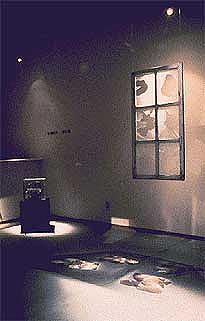
Holographic art and installations were extremely fragile in the 70's - most of the holograms were on glass, typically on silver-halide emulsions, and some installations required fragile set-ups. At the conclusion of the touring exhibition (during which a number of pieces were damaged or destroyed in faulty exhibition circumstances, beyond the Mr. Grove's control), much of the remaining work was dispersed (like effects of entropy on matter) or exhibited individually (eg. Franklin Institute exhibition, or Eve Ritscher's European and U.K. (Bath and London) exhibitions. Some additional works by Razutis (created in the 80's) were also stolen in exhibition (Frankfurt), or destroyed in transit (Montreal) and storage (Los Angeles). Barely ten percent of the works survive to this day (2005). That's the way the proverbial 'cookie crumbles'? Closing the Vancouver studio, but not the story In 1977, I closed the Vancouver Studio of Visual Alchemy, leaving many items behind for interested parties to 'help themselves with', and I left for the Samoan Islands in the South Pacific to 'write novels'. Thus, the first chapter - that which dealt with invention and one of the origins of holographic art in Canada at Visual Alchemy in the 1970's - was closed. Holographic works by Razutis would continue through the 80's and 90's in other locations, each one a 'temporary home' for the studio that kept resurfacing as 'Visual Alchemy'. These further histories are found in other pages on this site. "This recounting of the details and events surrounding one of the 'births of holography' in Canada is dedicated to the above individuals and institutions without whom this work would not have been possible in the forms that resulted." -- A.R. This essay is companion piece to More links / resources: Visual Alchemy - holographic art on Exhibit @ 2012 NSA Conference, California: For updates on what is happening at Visual Alchemy visit us on FaceBook:
For more early history of Visual Alchemy holography see: 'Holographic Intentions' at Visual Alchemy ('Leaving Plato's Cave...') The 'esoterics' behind visual alchemy: 'Projecting - Alchemy' Complete listing of holographic art by date: Holographic Art by Al Razutis - Al Razutis 1972-2016 Holographics and art pictorial - Visual Alchemy - Pictorial history Sterep 3D Photos of Recent Works - Installations 2007-2013 Holographic arts - Razutis - MAIN PAGE
A list of Chapters concerning Alice A Visit to the
Cheshire Cat Eye Doctor [ TOP
OF PAGE ] RELATED TOPICS:
|
